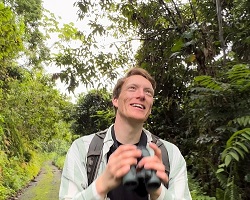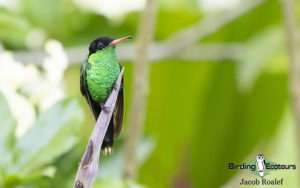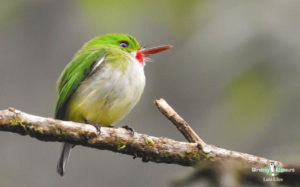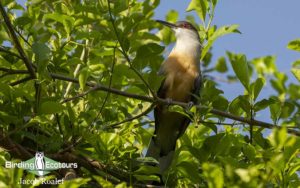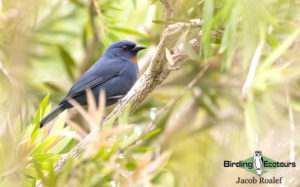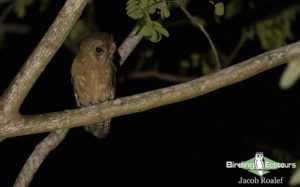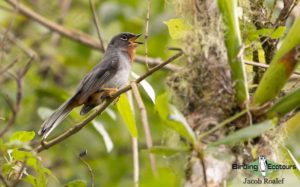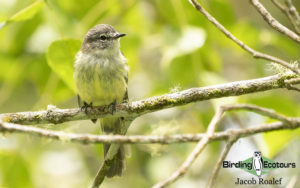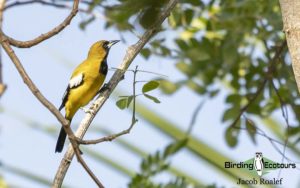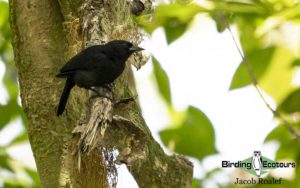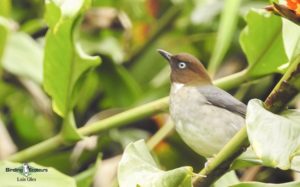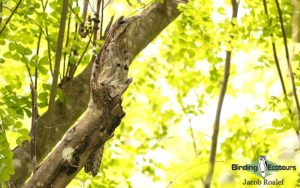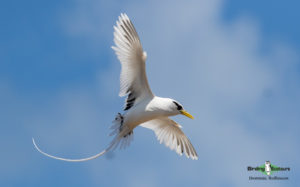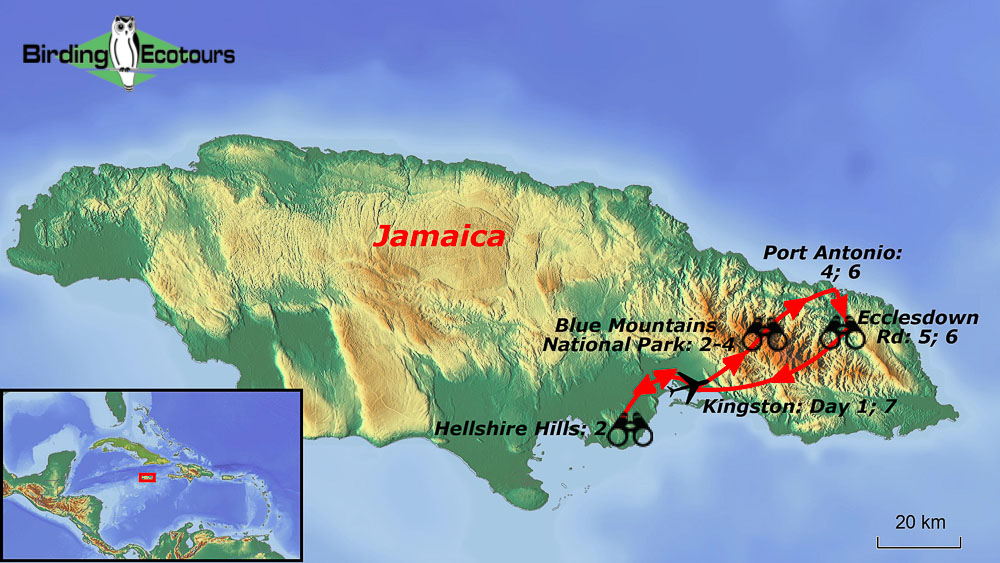Jamaica Birding Tour: Island Endemics in the Heart of the Caribbean
Jamaica Birding Tour: Island Endemics in the Heart of the Caribbean
March 2026
Birding Ecotours invites you to explore the island nation of Jamaica, an extraordinary country in the heart of the Caribbean Sea. Jamaica is famous for its beautiful tropical shores lined with coral reefs, beach resorts, Rastafarian culture, reggae music, Jamaica Blue Mountain Coffee, and early James Bond adventures. Importantly for us, this island is also home to 30 endemic bird species, along with a good number of Caribbean specials shared only with neighboring islands in the Greater Antilles.
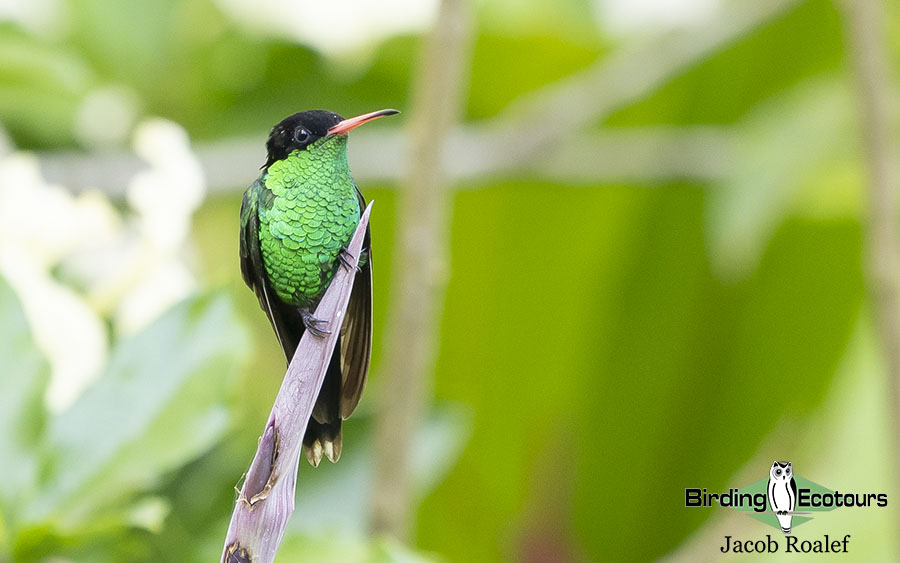
Being the third-largest island in the Caribbean, Jamaica hosts a wide array of habitats. On this tour we will explore various forested mountain ranges, lush lowland coastal bush, coastal shores, and several wetlands, giving us what are sure to be some of the finest birding experiences in the Caribbean. Our week-long tour will give you a realistic chance of seeing all of Jamaica’s bird endemics. These include the gorgeous Red-billed Streamertail (known locally as the doctor bird), Jamaican Mango, Crested Quail-Dove, Jamaican Tody, Jamaican Owl and Jamaican Blackbird. We hope to find all these, along with many other regional specialties, in a comfortable time frame without rushing the trip. We will also make a special effort to look for the beautiful White-tailed Tropicbird while on the island.
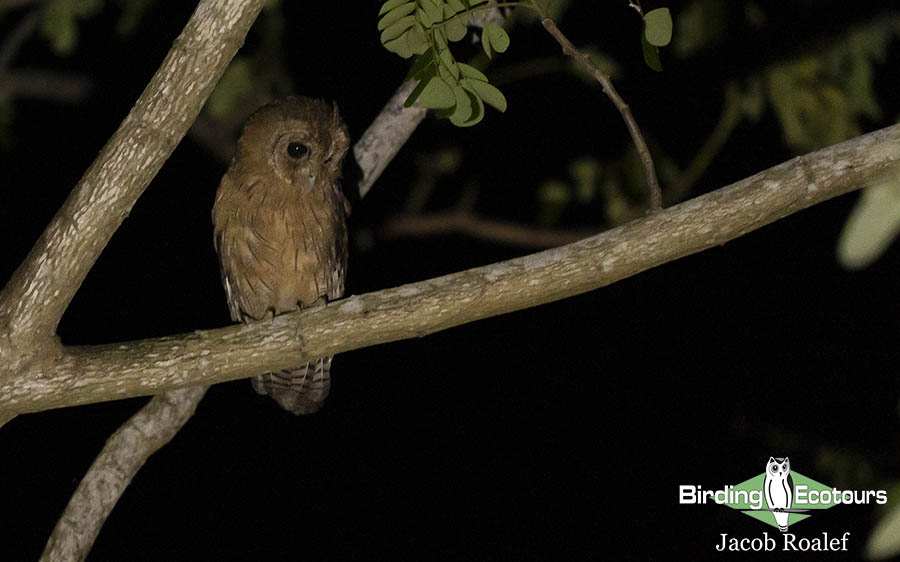
This tour begins with some birding around the capital city, Kingston, before we head into the heights of the spectacular Blue Mountains National Park, then on to Portland Parish, our base to explore the John Crow Mountains National Park. We have chosen lodges giving the best access to the birding sites, when possible with good birds within their grounds. With ample time to explore the diverse Blue and John Crow Mountains National Park and Ecclesdown Road, this tour is perfect for a great week of birding, targeting all of Jamaica’s endemic bird species.
This trip can easily be combined with our Cuba: Endemics and Culture in Paradise tour and our Complete Dominican Republic tour for a comprehensive birding experience in the Caribbean.
Itinerary (7 days/6 nights)
Day 1. Arrival in Jamaica
Today is a travel day and you can arrive at your leisure in Kingston, Jamaica (though, we suggest arriving before 2 pm to be able to join us for some local birding). After a short transfer from Norman Manley International Airport, we check in at our comfortable hotel in Kingston. If time permits, we will visit one of the city parks to start getting familiar with Caribbean birds. This will act as a great introduction to birding in Jamaica, and we hope to start seeing our first endemics of the tour, such as Yellow-billed Amazon, White-chinned Thrush, and Jamaican Woodpecker.
Overnight: Terra Nova All Suite Hotel or similar
Day 2. Birding Kingston and the Hellshire Hills
We first travel to the arid Hellshire Hills to the south-west of Kingston, an area which is more reminiscent of an African savanna than of a Caribbean coastline. The coastal scrub-woodlands are productive for Jamaica’s dry-forest species. Our principal target will be Bahama Mockingbird, a very localized species in Jamaica, found only here and in adjacent Clarendon Parish. Our other major targets will be the endemic Jamaican Vireo and near-endemic Stolid Flycatcher, which, while present throughout the island, are more common in arid woodlands. Here we have a good chance of encountering the stunning endemic hummingbird, Jamaican Mango, alongside the tiny Vervain Hummingbird as it darts between flower patches – although only a mere inch larger than the world’s smallest bird (and close relative, the Bee Hummingbird) this species makes up for its size with a lot of character!
Leaving Hellshire Hills we visit wetlands along the western edge of Kingston where we should see a range of waterbirds such as Northern Jacana, Purple Gallinule, Least Grebe, and Black-necked Stilt, alongside waders and heron species, with Least Bittern, and Tricolored Heron perhaps the most notable. The grassland and scrub surrounding these wetlands are frequented by comical parties of Smooth-billed Ani, small groups of Saffron Finch, and wintering neotropical warblers, while groups of Cave Swallow swirl overhead.
We eventually depart for the Blue Mountains National Park, a UNESCO World Heritage Site, where we have a two-night stay nestled within montane forests of the Silver Hill Gap where we seek Jamaica’s rarest birds.
Overnight: Starlight Chalet. This is basic accommodation but is in the best position for birding.
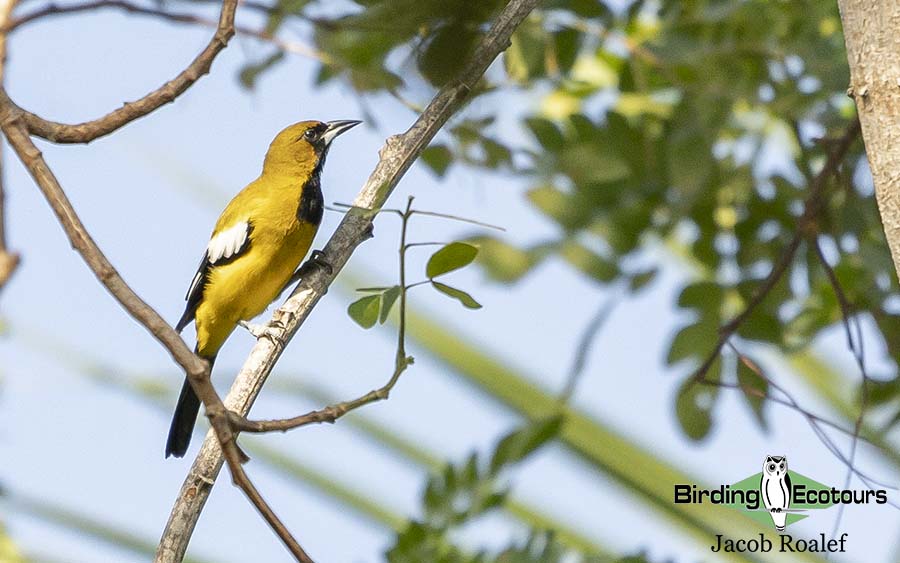
Day 3. Birding the Blue Mountains National Park
At almost 4,000 feet (1,220 meters) above sea level, the Blue and John Crow Mountains National Park is classified as an Important Bird Area by BirdLife International and host the rarest of Jamaica’s endemics. Today we’ll focus on birding the Hardwar Gap, Silver Hills Gap, and Cascade Falls, these sites all merge seamlessly into each other along a rugged mountain road on the cool western slopes of the Blue Mountains National Park.
Our lodge is well situated, nestled high in the Silver Hill Gap, and with an early departure we will be in prime position to find the secretive Crested Quail-dove, which is often seen waddling along the forested edges of the road in the early morning. We will visit the Hardwar gap area early as it is perfect for Rufous-throated Solitaire – a gorgeous bird we will try to find by following its haunting whistles. Out on the trails and along the mountain road, we will search for the unobtrusive Jamaican Elaenia and Greater Antillean Bullfinch, and the region’s namesake, the Blue Mountain Vireo. The vireo is very localized, being found only here and in Cockpit Country, and is a secretive species, often creeping quietly through dense vegetation, but it is common enough in the right habitat. One of the most exciting prospects of birding these high-elevation forests, however, is the chance of encountering a mixed species flock, with Jamaican Becard, Jamaican Spindalis, and Arrowhead Warbler sometimes present in these. The unusual Jamaican Blackbird may associate with these flocks too, and hopefully we will see them foraging in epiphytes and tree ferns. Another section is ideal for finding small parties of White-eyed Thrush and is, importantly, one of the best places for Greater Antillean Elaenia. At this time of year, the species will be returning to high-elevation forests in preparation to breed, but pairs will often join mixed species flocks.
Although we’ll be targeting the more localized species, 28 of the 30 Jamaican endemics have been recorded within the Blue Mountains National Park, and many migrants winter here so birding can be very productive. We will relax at the lodge when the birding quietens down but have the option to bird again in the afternoon once things start moving again, either visiting the lodge trails or picking another local site depending on our targets.
Overnight: Starlight Chalet. This is basic accommodation but is in the best position for birding.
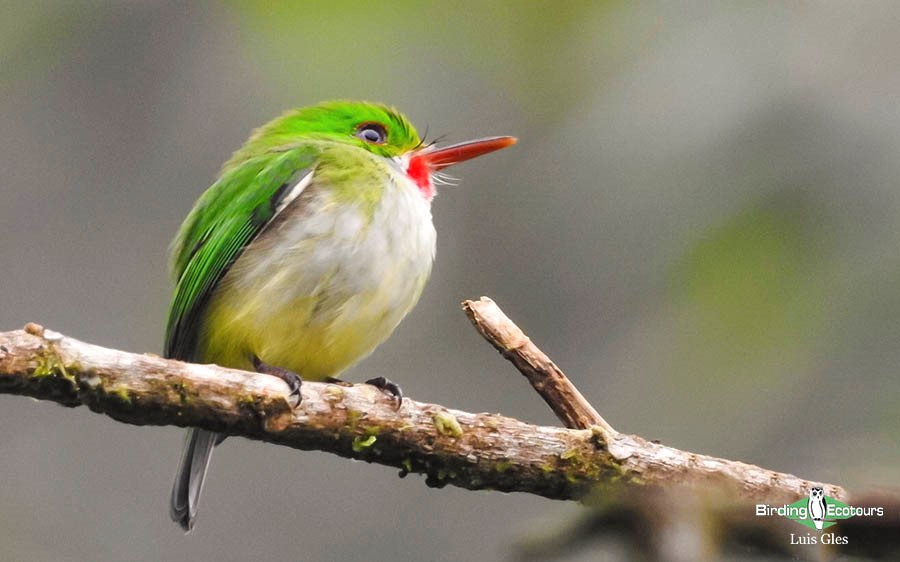
Day 4. Birding the Blue and John Crow Mountains and transfer to Port Antonio
As with all great birdwatching in the Caribbean, ours will be at a relaxed pace and today we plan to bird the grounds and nearby trails of Starlight Chalet. We will take time to enjoy good views of many of the Jamaican endemics which are in abundance here, including one of the world’s most iconic species, Red-billed Streamertail – as males jostle over flowers in the garden and chase one another, displaying their gorgeous tail streamers. The gardens and surrounding forests host colorful and exotic endemics such as Jamaican Oriole, Jamaican Woodpecker, Jamaican Euphonia, Orangequit, and the unobtrusive but incredibly beautiful Jamaican Tody. We hope to find the bird known locally as the ‘Old Man Bird’ – Chestnut-bellied Cuckoo, which is surprisingly nimble despite its size. We will have a good chance of finding many of Jamaica’s endemic tyrant flycatchers too, with Jamaican Pewee, Sad Flycatcher and Rufous-tailed Flycatcher all seen regularly.
After an exciting morning, we will descend from the mountains and transfer to Port Antonio in the north-east of the island, to relax at our hotel for the afternoon. Here, Black-billed Streamertail replace their red-billed counterparts and on arrival at the Hotel Mockingbird, we should be greeted by these gorgeous hummingbirds as they squabble over the feeders. Jamaican Mango is also usually in attendance, and while it’s likely we would have encountered this species previously, here we can enjoy prolonged views of these lovely and surprisingly timid birds. The hotel is situated near good quality lowland forest, which is especially productive for the globally threatened Ring-tailed Pigeon, which is satisfyingly abundant here, and busy flocks often pass overhead.
After eating some of the best Jamaican food, we will look for one of the less common endemics, the Jamaican Owl, which is resident within the grounds and often picked out by its hoarse, far-carrying calls. We will also look for the local subspecies of American Barn Owl, and Northern Potoo, which can often be found right outside the hotel.
Overnight: Hotel Mockingbird Hill
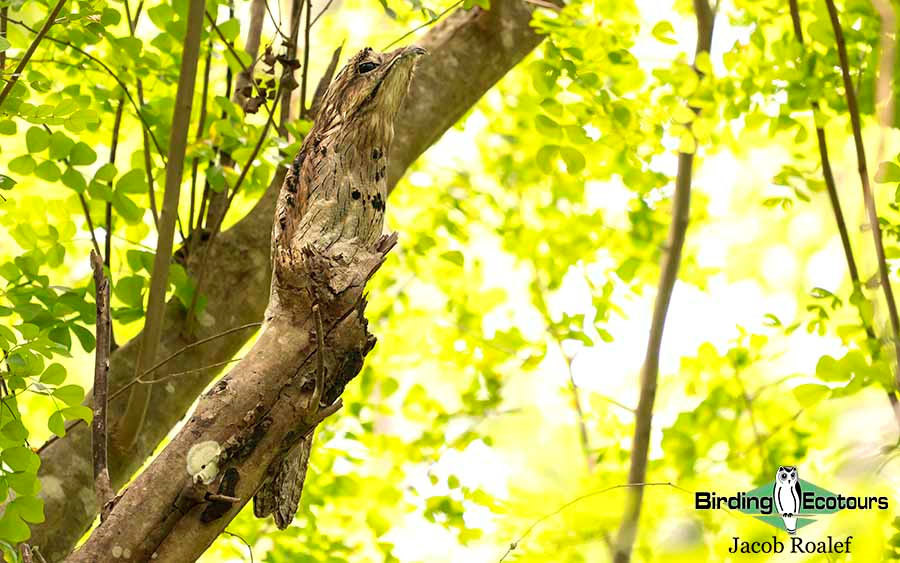
Day 5. Birding the Ecclesdown Road
Today we will have an early departure from our eco-lodge as we head to the far east of the island, to explore Ecclesdown Road. This is one of the country’s best-known birding sites: an overgrown and seldom-used road that travels along the foothills of the John Crow Mountains for approximately eleven miles (18 kilometers). Ecclesdown Road winds through a mix of secondary closed and open forests as well as small patches of scrub, cultivation, and plantation, which together create a very productive area to bird. We will spend a long morning slowly birding along this flat road, making our way back to our lodge in the afternoon. This promises to be an exciting morning, as here we have chances at finding most of Jamaica’s endemics along with many other specials, and we will devote our time to the species we still need. Our main targets are likely to be Black-billed Amazon, which appear to be more numerous than Yellow-billed Amazon here, and Yellow-shouldered Grassquit, as small groups forage along the roadside and forest-scrub edge. Ecclesdown Road is also good for Jamaican Crow, which, despite uninspiring plumage, has remarkable vocalizations comprised of mechanical gurgles, clucks, pops, and jabbering. Other species of interest include the Jamaican subspecies of the raucous Olive-throated Parakeet, Ring-tailed Pigeon, Crested Quail-Dove, Jamaican Blackbird and Black-billed Streamertail.
Once we have had our fill of Eccelsdown, we will start heading back to our eco-lodge, but we’ll check for impressive White-tailed Tropicbird and Magnificent Frigatebird which can be seen just offshore. We can also check for wintering Belted Kingfisher, which fishes from the beaches and mangroves. Returning in good time, we will have the afternoon at leisure, to either enjoy birding the hotel veranda and gardens, or visit the beautiful Frenchman’s Creek.
Overnight: Hotel Mockingbird Hill
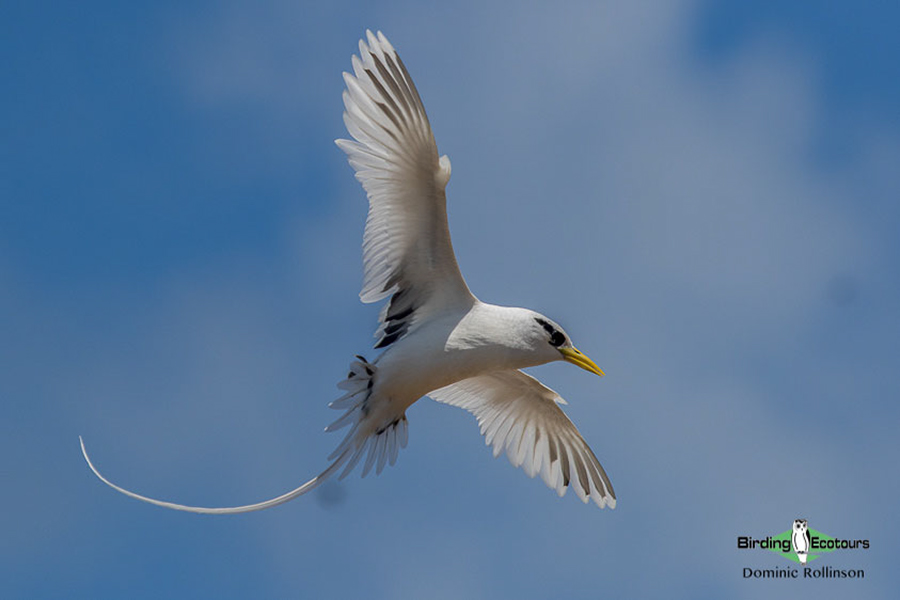
Day 6. Birding Portland Parish
Our sixth day in Jamaica will be flexible and we have a wide variety of options available to us. Should we have missed any notable birds on the Ecclesdown Road, or indeed within the Blue Mountains, we will undertake a trip into these areas to try once more. Alternatively, there are productive sites close to our eco-lodge which we may choose to explore instead, particularly if we have yet to encounter the cautious Jamaican Lizard Cuckoo, or ‘Old Lady Bird’ as it’s known locally, as the dense forests near Frenchman’s cove and San-San beach are a familiar haunt for this uncommon endemic. These coastal forests can be an exciting prospect to bird as they are a hotspot for neotropical migrants, so we’ll have a chance of seeing some less commonly encountered species in Jamaica, such as Worm-eating Warbler, and Yellow-bellied Sapsucker. However, given that most of Jamaica’s endemics have been recorded within the grounds of our eco-lodge, we may opt to bird from the comfort of the lodge. Time here will be put to good use with many excellent birds possible, and it will allow photographic opportunities for spectacular Black-billed Streamertail or Jamaican Mango. Should it be of interest, we can help arrange a trip to experience one of the natural beauty spots which Jamaica is renowned for (please note this may require additional costs).
Overnight: Hotel Mockingbird Hill
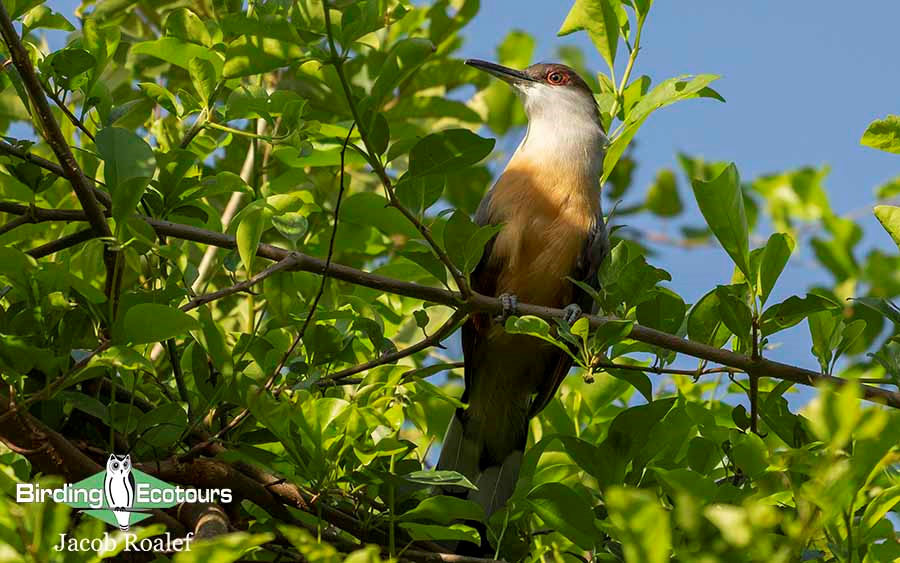
Day 7. Departure from Kingston
Following a spectacular week, this tour will conclude after breakfast when we will transfer back to Kingston where the tour will end. If time allows, we may drop into one of the coastal wetlands for some final Jamaican birding before departing, particularly if West Indian Whistling Duck or American Flamingo have been reported in the area. Please note, we ask if you can try to book afternoon or evening flights out of Kingston to allow for necessary travel time (at least three hours to the airport) and flight check-in formalities.
Don’t forget to check out our Cuba: Great Caribbean Birding and Endemics tour and Complete Dominican Republic tour to extend your amazing Caribbean birding experience!
Please note that the itinerary cannot be guaranteed as it is only a rough guide and can be changed (usually slightly) due to factors such as availability of accommodation, updated information on the state of accommodation, roads, or birding sites, the discretion of the guides and other factors. In addition, we sometimes have to use a different international guide from the one advertised due to tour scheduling.
Download ItineraryJamaica Birding Tour: Island Endemics in The Heart of the Caribbean Trip Report
22 – 28 MARCH 2025
By Fraser Bell
DOWNLOAD TRIP REPORT
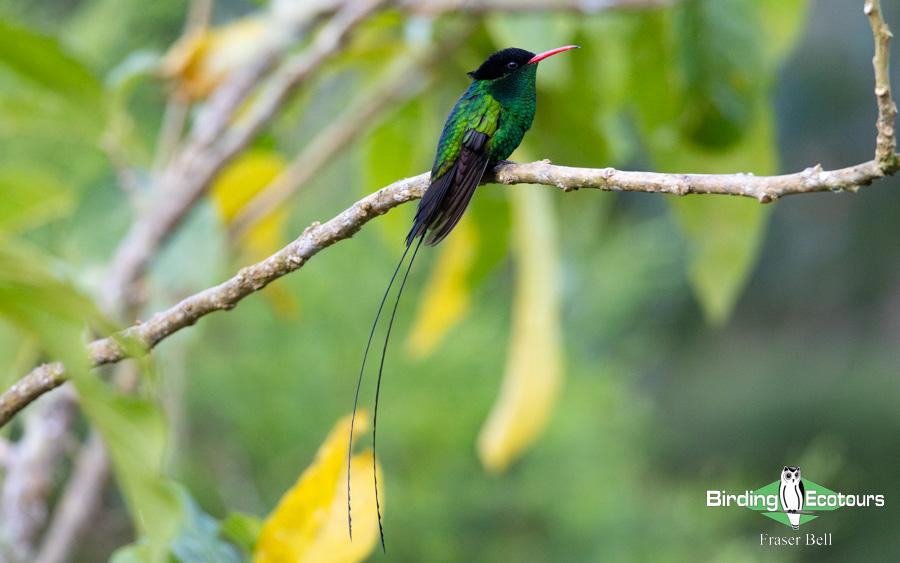
Red-billed Streamertail was our bird of the trip. They are iconic, charismatic, and really great to watch as they jostle one another at flowers and feeders.
Overview
This birding tour of Jamaica began in Kingston on 22nd of March 2025, and concluded there on 28th March 2025. The tour focus was to see all 28 of the country’s currently recognized and extant endemic bird species (which we did), key migrants, and a number of Caribbean specials found only in the Caribbean, southern Florida, or Mexico’s Yucatán Peninsula. We also enjoyed close encounters with White-tailed Tropicbird, endemic reptiles, and found a few rare migrants!
The tour began with birding at some coastal wetlands between the airport and our hotel in Kingston, before we checked in for the night. The following day we visited the dry, cactus scrub of Hellshire Hills and then the Greater Portmore Sewage Ponds, before turning our attention to Jamaica’s 28 endemic bird species. After lunch, we explored Kingston’s Hope Botanical Gardens for a great introduction to some of the island’s more common endemics, before heading up into the beautiful Blue Mountains. We checked in for a two-night stay at Silver Hill Gap and spent a full day birding the excellent sites in the area, such as Hardwar Gap. Coming down from the mountains, we headed north to the coast, then east, first stopping at the Spanish River Bridge to look for waterbirds, before arriving at our peaceful accommodation in San San, in northeastern Jamaica. We had two days based in this area, travelling as far south as Happy Grove, and birding the famous Ecclesdown Road, along with more local sites such as San San Police Station Road and Sherwood Forest. After an early departure for Kingston, we dropped some of the group at the airport before ending the tour with some final birding around Port Royal.

Watching White-tailed Tropicbird near their nesting cliffs in eastern Jamaica is a mesmerizing experience not easily forgotten.
We recorded 125 bird species on this Jamaica birdwatching tour. A major highlight was seeing all 28 of Jamaica’s extant endemic bird species, including Red-billed and Black-billed Streamertails, Jamaican Lizard Cuckoo, Crested Quail-Dove, Jamaican Owl, Jamaican Tody, Black-billed Amazon, Jamaican Becard, Blue Mountain Vireo, Jamaican Spindalis, Jamaican Blackbird, Arrowhead Warbler, and Yellow-shouldered Grassquit. We also enjoyed finding a number of Caribbean specialties, such as Caribbean Dove, Vervain Hummingbird, Greater Antillean Elaenia, and Bahama Mockingbird. In addition, we encountered many migratory species wintering on the island, and found a few vagrants which are rarely recorded in Jamaica, such as American Golden Plover, Ring-billed Gull, and Prothonotary Warbler.
In addition to the exceptional birding, we encountered an exciting variety of reptiles during the tour, including American Crocodiles, the near-endemic Croaking Lizard, and four endemic Anoles such as the Jamaican Giant and Stripefoot Anoles.

The Jamaican Tody, or ‘Rasta Bird’, is a beautiful species that reflects the charm of birding in the Caribbean.
Bird and animal lists for this Jamaica birding tour follow the report and you can also view the eBird trip report here, where you can see more bird photos.
Detailed Report
Day 1, 22nd March 2025. Arrival in Jamaica
The group met at Norman Manley International Airport in Kingston in the early afternoon, and despite the hot, windy conditions, we decided to get the birding underway. We visited a stretch of coastline just east of the airport, where we watched Royal Terns, Cabot’s Terns, Laughing Gulls, and Brown Pelicans loafing just offshore. One of the Royal Terns had been color banded as a juvenile in Virginia, United States, in June 2024, and now wintering in Jamaica. Royal Terns are particularly interesting, as some individuals stay near their breeding areas year-round, while others, like this one, migrate south for the winter.
Continuing our birding, we visited a flooded ditch that turned out to be a hotspot for waterbirds. Here we saw a large group of Black-necked Stilts, along with Glossy Ibis, Grey Plover, Killdeer, Lesser Yellowlegs, Least Sandpiper, Ruddy Turnstones, and Sanderlings, as well as herons like Tricolored, and Little Blue Herons, and both Snowy and Western Cattle Egrets. Among the familiar Mourning Doves, we picked out our first Zenaida Doves -a subtly beautiful Caribbean specialty. Surprisingly, the rarest sighting of the day came in the form of a group of Eurasian Collared Doves, an introduced species slowly spreading across Jamaica. After check in, the group chatted about the exciting week ahead and our many endemic targets over a delicious dinner.
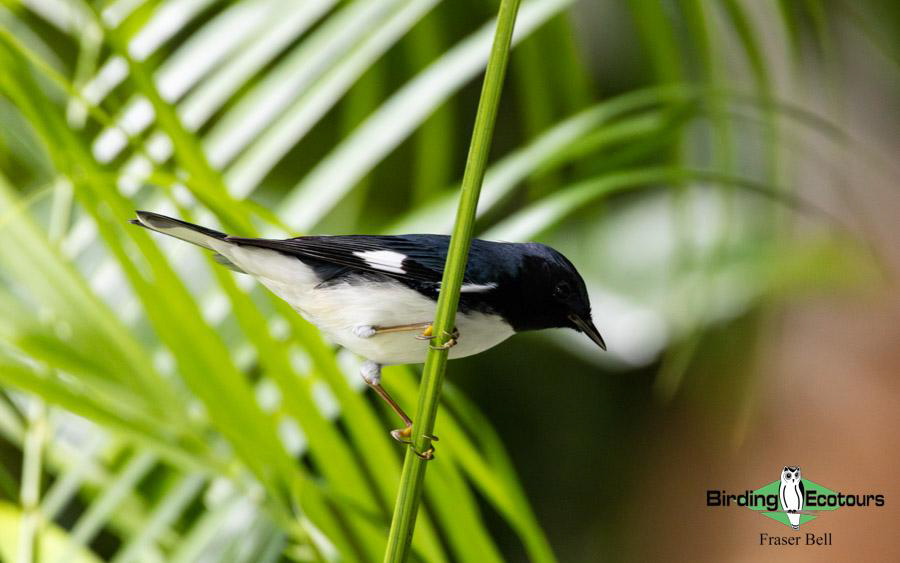
Jamaica is a great place to see migratory wood warblers in their beautiful spring plumage. This male Black-throated Blue Warbler was one of fifteen warbler species we saw on our tour.
Day 2, 23rd March 2025. Birding Kingston and the Hellshire Hills
After sampling tasty Jamaican dishes at breakfast, we checked out and headed west through Kingston towards the arid dry scrub of the Hellshire Hills. It was a long, hot morning, but a rewarding one! Our first new additions, spotted at some wetlands on entering the area, were a flock of Cave Swallows, a pair of Blue-winged Teals, and Semipalmated and Wilson’s Plovers feeding along the beachline. Not long after, we found our first endemic, the Yellow-shouldered Grassquit. Initially elusive, everyone eventually had good scope views of this neat little endemic. We then moved on to the cactus scrub of the Hellshire Hills, a striking landscape set against the backdrop of the turquoise Caribbean Sea. We picked up our main targets quickly, with the near-endemic Stolid Flycatcher, Bahama Mockingbird, and Vervain Hummingbird all seen well, and also enjoyed watching a Reddish Egret performing its distinctive, frantic feeding dance. We came across several of the endemic Melocactus caroli-linnaei scattered among the rocks and scrub, an interesting feature of this unique habitat.
Leaving the Hellshire Hills, we arrived at the Greater Portmore Sewage Ponds in the late morning. Despite the heat and a digger working in the reeds, we did well here. Among the abundant herons, we added Purple Gallinule, Northern Jacana, Least Grebe, and a trio of introduced songbirds; Scaly-breasted and Chestnut Munias, along with a large flock of Yellow-crowned Bishops. Although there were no waterfowl or wading birds present, we did see American Crocodile, and a Least Bittern, which was flushed by the digger and flapped awkwardly over a pool before disappearing into some distant reeds.

Camouflaged Northern Potoo are easily found at their day roosts in Jamaica.
After a feast of Jamaican curries for lunch and a chance to cool off, we visited Kingston’s Hope Gardens. Here we had good views of three parrot species; Yellow-billed Amazons, and Olive-throated, and Rose-ringed Parakeets. We saw our first wintering New World warblers, with American Redstarts, Northern Parulas, and Prairie, Black-throated Blue, and Cape May Warblers all seen well. An adult Cape May Warbler showed brilliantly, and we all enjoyed watching it drink nectar from flowering trees. A trio of roosting Northern Potoos were unsurprisingly group favorites, as were several pairs of Jamaican Woodpeckers and a very showy Red-billed Streamertail. The Streamertail is such an iconic hummingbird, and satisfyingly abundant throughout much of Jamaica. After the gardens, we headed up into the heights of the Blue Mountains, enjoying the stunning landscape as we climbed to Starlight Chalet, nestled in the Silver Hill Gap. We finished this busy, bird-filled day with some tasty Jamaican jerk food while listening to reggae.
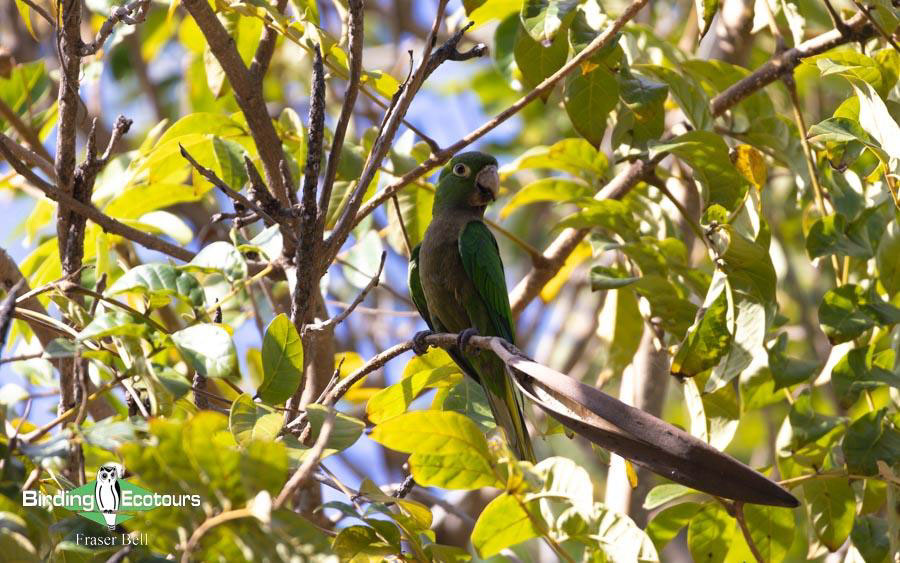
The nana subspecies of Olive-throated Parakeet in Jamaica is a good candidate for a potential future split, with some authorities already recognizing it as the ‘Jamaican Parakeet’.
Day 3, 24th March 2025. Birding the Blue Mountains National Park
We started the day at first light, fueled by Blue Mountain coffee, and headed down into the Silver Hill Gap to target one of Jamaica’s most elusive endemics. Our first new bird was the gorgeous Jamaican Tody, or ‘rasta bird’ as it’s known locally. This charismatic little gem, from a family endemic to the Greater Antilles, is always great fun to watch. We also saw the aptly named Orangequit, Jamaican Euphonia, and three of the four endemic flycatchers; Jamaican Elaenia, Jamaican Pewee, and Rufous-tailed Flycatcher. Seeing an endemic Arrowhead Warbler alongside the much more familiar Black-and-white Warbler was interesting, as it gave everyone a chance to appreciate how different these two species are. Our main target, though, was the shy Crested Quail-Dove and, just as we considered moving on, one flew onto the road nearby and waddled around, letting us admire its subtle crest and glossy plumage. We followed as it dropped down the bank and joined a second bird, and watched them feeding quietly in the leaf litter.
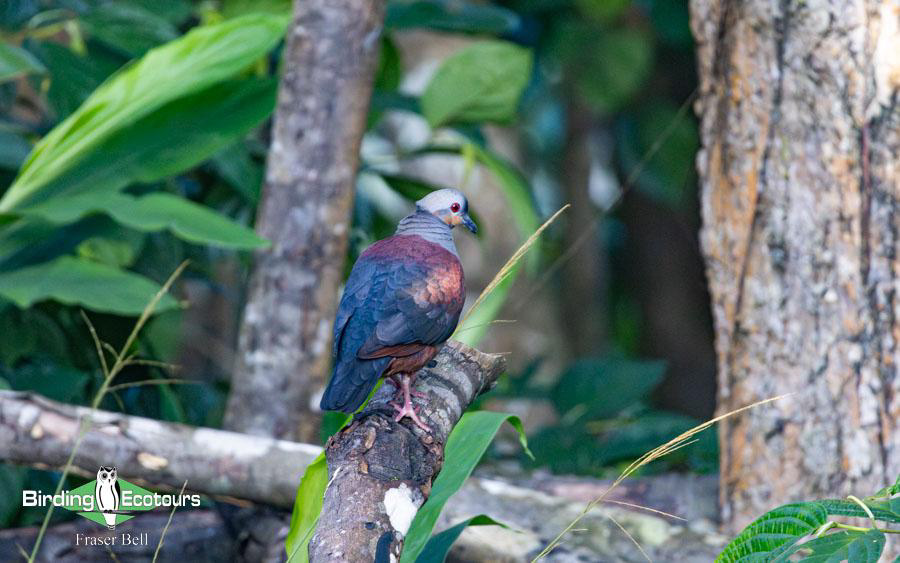
We saw two endemic Crested Quail-Doves up close on our first morning in the Blue Mountains.
After a relaxed breakfast, we headed back out, this time bound for the Hardwar Gap area. Each stop produced excellent views of a new Jamaican endemic, including Chestnut-bellied Cuckoo, a pair of Blue Mountain Vireos, and small groups of Jamaican Vireos, White-eyed Thrushes, bright Jamaican Spindalis, and a few rare Jamaican Blackbirds. We especially enjoyed watching the Chestnut-bellied Cuckoo as it bounced through branches in the understory. We also improved views of both Jamaican Oriole and Sad Flycatcher, two fairly common species we had only glimpsed before, and added White-collared Swift and Greater Antillean Bullfinch to our trip list. After lunch at one of the many excellent Blue Mountain cafés, we continued birding while making our way back to our lodge in the Silver Hills.
We scored our two final Blue Mountains targets with walk-away views of a Rufous-throated Solitaire guarding a fruit-laden tree, followed by a Greater Antillean Elaenia in the canopy. The Elaenia is a tough species to see, being an unobtrusive canopy species. It is only found on Jamaica or Hispaniola, but with the nominate Jamaican subspecies being a potential future split, we were pleased to connect with one. We returned to the lodge for some downtime, and while our evening attempt for Jamaican Owl didn’t deliver, the fun atmosphere at the lodge and great Jamaican food made up for it.
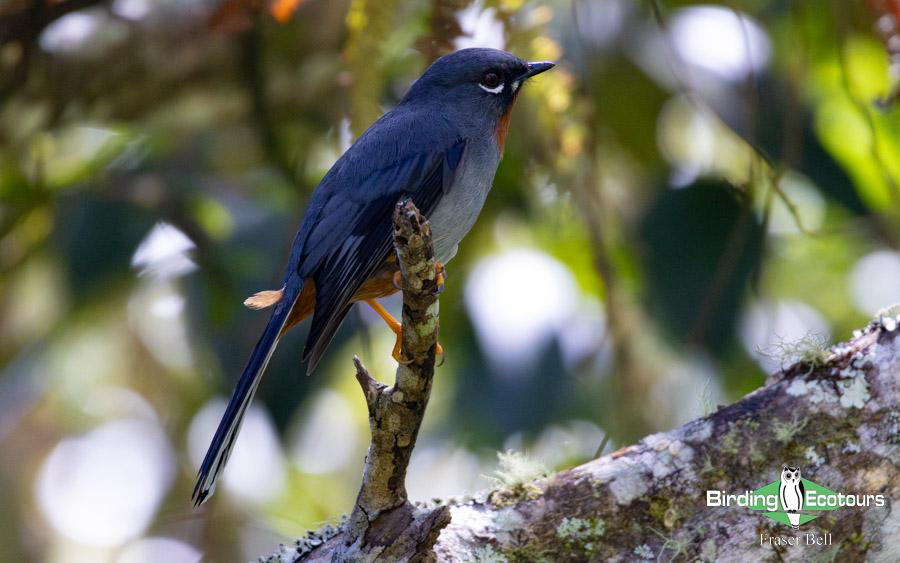
This showy Rufous-throated Solitaire was a group favorite. It was beautiful to hear their haunting calls during our time in the Blue Mountains.
Day 4, 25th March 2025. Birding the Blue Mountains and transfer to Port Antonio
Given we were based in ideal birding habitat, we chose to stay local and bird near the lodge. After our daily dose of Blue Mountain coffee, we walked the quiet mountain roads, improving views of several endemics we’d seen earlier in the trip, including Yellow-shouldered Grassquit and Jamaican Blackbird. The highlight was finally catching up with a pair of Jamaican Lizard Cuckoos. The birds gave excellent views as they moved through the low trees around us, gliding between branches, running and hopping along limbs, occasionally fanning their tails, and exchanging their low rattling calls. We also added Black-whiskered Vireo, Shiny Cowbird, Palm Warbler, and Common Yellowthroat to our trip list.
We left after breakfast, heading for Port Antonio in the northeast. We first stopped to get some locally grown coffee, which turned out to be a productive stop for birding as we had close views of the minuscule Vervain Hummingbird, and much better looks at Greater Antillean Elaenia than the day before. Once at the coast, we continued east but paused at Spanish River Bridge. While birding here isn’t the most relaxing, being right next to a main road, it was a worthwhile stop and we added Belted Kingfisher, Pied-billed Grebe, Barn Swallow, and Black-crowned and Yellow-crowned Night Herons. The highlight was a mixed flock of six neotropical warbler species, including our only Magnolia Warbler of the trip and two Prothonotary Warblers – vagrants to Jamaica, so it was quite a buzz finding this pair! We continued on and arrived at Goblin Hill Villas in San San, which, with its extensive grounds and warm hospitality, was a fantastic place to end the day. Here three species of endemic Anole lizards were common, with the Stripefoot Anoles always present around the restaurant, and joined at night by the very loud near-endemic Croaking Lizard (actually a large gecko!).

Jamaican Lizard Cuckoo is a brilliant bird and always entertaining to watch.
Day 5, 26th March 2025. Birding the Ecclesdown Road
We left our villas while it was still dark and drove east, then south along the Caribbean coast. As soon as we arrived at Hector’s River, we spotted our target White-tailed Tropicbirds whirling across the bay and chasing one another. They breed in the cliffs here, and we enjoyed watching them swoop past at close range while eating our packed breakfast. It was a real treat to see such stunning birds so well.
We then drove to bird the infamous Ecclesdown Road. We found one of our remaining endemic targets straight away, as a pair of Black-billed Amazons flew in right beside us and stayed long enough to give everyone a chance to see the differences between these and the more common Yellow-billed Amazon. We also added two stunning endemic hummingbirds to our trip list, finally seeing Jamaican Mango well, along with our first of many Black-billed Streamertails. Continuing along the road, we encountered our first Jamaican Becard, a very vocal female which the whole group could enjoy. While we had been hearing the odd vocalizations from Jamaican Crows throughout the morning, after a few hours of trying for them, we finally spotted a pair in a valley below us. That was cause for celebration, as it marked our penultimate Jamaican endemic with just the Owl remaining! We finished at Ecclesdown by finding a mixed warbler flock, which included a Worm-eating Warbler, and then improved our views of Arrowhead Warbler and the sweet Jamaican Tody.
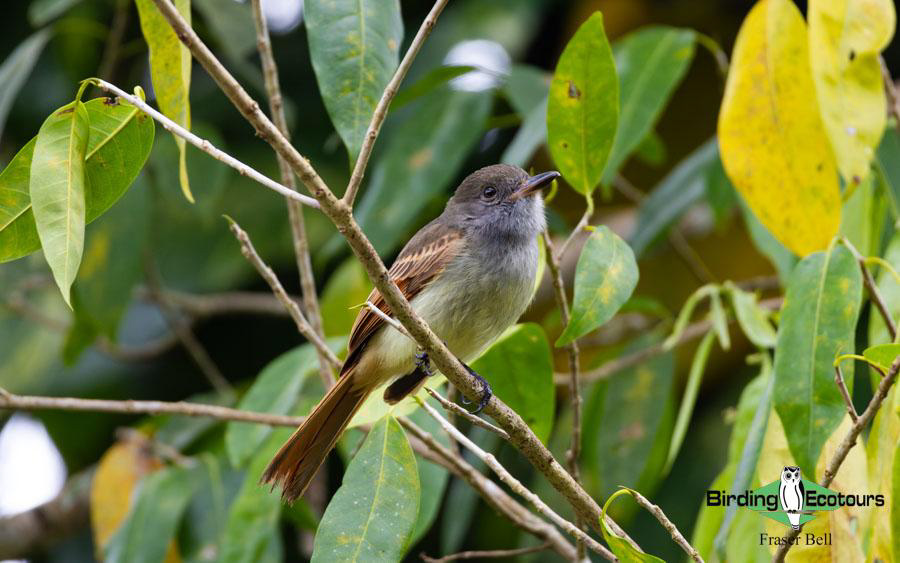
Rufous-tailed Flycatcher are Jamaica’s largest and most distinctive endemic flycatcher.
Our Ital (a plant-based diet associated with the Rastafari movement) lunch worked a treat and, given our morning’s success, we had the afternoon to relax or enjoy the extensive grounds around our villas, where both Jamaican Mango and Black-billed Streamertail visit feeders. That evening, we completed our quest to see the Jamaican endemics by finding a pair of Jamaican Owls. We saw both adults and also heard a chick calling in response to the adults’ lion-like roars.
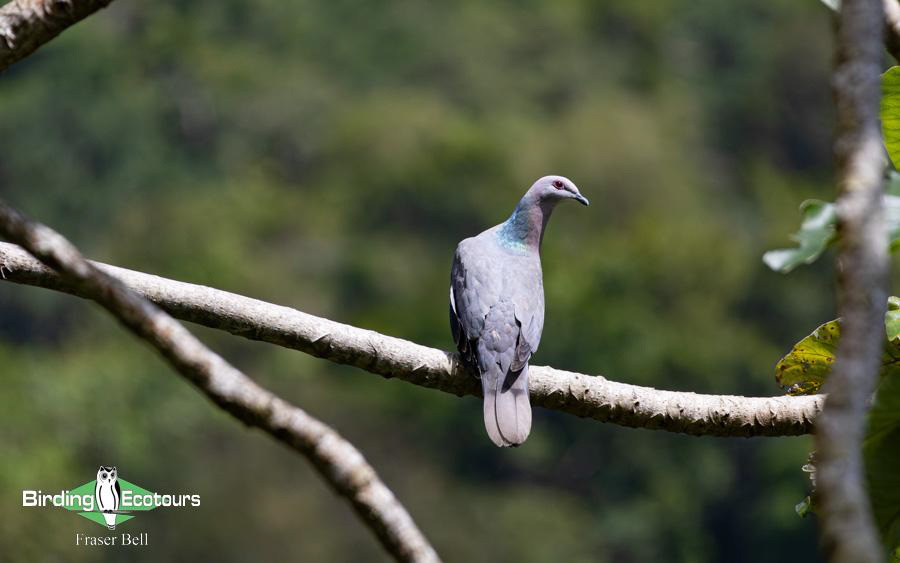
While we saw many Ring-tailed Pigeon flocks in flight during the tour, it was satisfying to find a small group in a roadside tree so everyone could see their diagnostic features, such as the subtle ring-tail.
Day 6, 27th March 2025. Birding Portland Parish
Our destination was a road that winds through lowland rainforest, close to our accommodation, where we hoped to encounter two dove species. We heard Caribbean Doves calling regularly throughout the morning but only managed very brief, in-flight views. We fared better with Ruddy Quail-Dove, and although sightings were short, most of the group saw one of three birds that flushed from the forest or path. After a heavy rain shower set in, we headed back to our accommodation for a well-timed breakfast before returning to the forest later in the morning. Bird activity picked up again, and the highlight was a vocal Mangrove Cuckoo, which showed well and gave close, prolonged views. We also had repeat looks at many of the endemics we had become familiar with over the past week, including Jamaican Woodpecker, Yellow-billed Amazon, Jamaican Spindalis, Arrowhead Warbler, Yellow-shouldered Grassquit, and three very vocal Jamaican Becards, including, finally, a glossy black male.
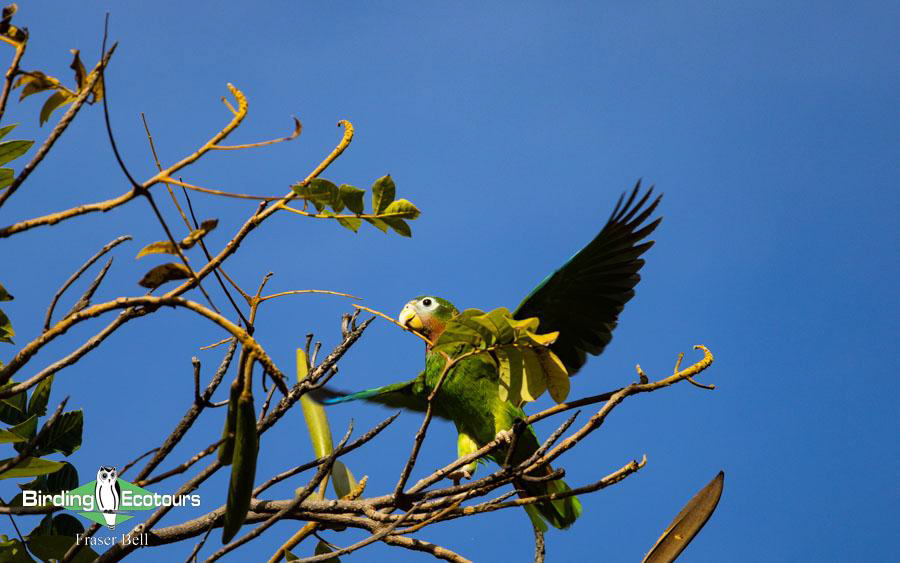
Yellow-billed Amazon are one of the more common of Jamaica’s endemics.
Lunch was either Ital or the famous Jamaican Boston Jerk Chicken (where jerk chicken originated!), after which we visited another local site for one last chance at our final tour target. We hadn’t even parked before we saw it – a lovely plump Caribbean Dove waddling across the road, which stayed long enough for everyone to get out and take pictures of this attractive dove with an oddly disjunct range. We then gave our attention to the large flocks of both Black-billed and Yellow-billed Amazons, Olive-throated Parakeets, and had our best looks at the endemic Rufous-tailed Flycatcher, as a small group foraged in a roadside tree. Satisfied with our efforts, we headed back to relax at our accommodation for the afternoon and enjoyed one final Jamaican dinner together. The charismatic Red-billed Streamertail was voted bird of the trip, fitting given its beauty and character.
Day 7, 28th March 2025. Departure from Kingston
We had an early start and departed Portland Parish, heading around the Blue Mountains to Kingston Airport. Most of the drive was through heavy rain, so we were lucky that it had cleared by the time we dropped some of the group at the airport. The rest of us continued to the nearby town of Port Royal for one last birding adventure. Port Royal, located at the end of the spit of land below Kingston, was once a pirate stronghold, still evident in the town’s architecture. Here we birded the beaches, cactus scrub, and docks. We added American White Ibis and Mangrove Warbler, the latter part of a nice mixed warbler flock. Among the many Laughing Gulls, we had a stroke of luck and found the vagrant Ring-billed Gull that had been hanging around the area. Even better, we then found an American Golden Plover. This is a rare migrant to Jamaica, so it was a real thrill to come across it along a quiet shoreline just east of Port Royal.
With rain threatening again, we returned to our Kingston hotel where the group said our farewells. What a fantastic Jamaican birding adventure it had been, with a mega 125 species seen, and an amazing bunch of birders to experience it with.
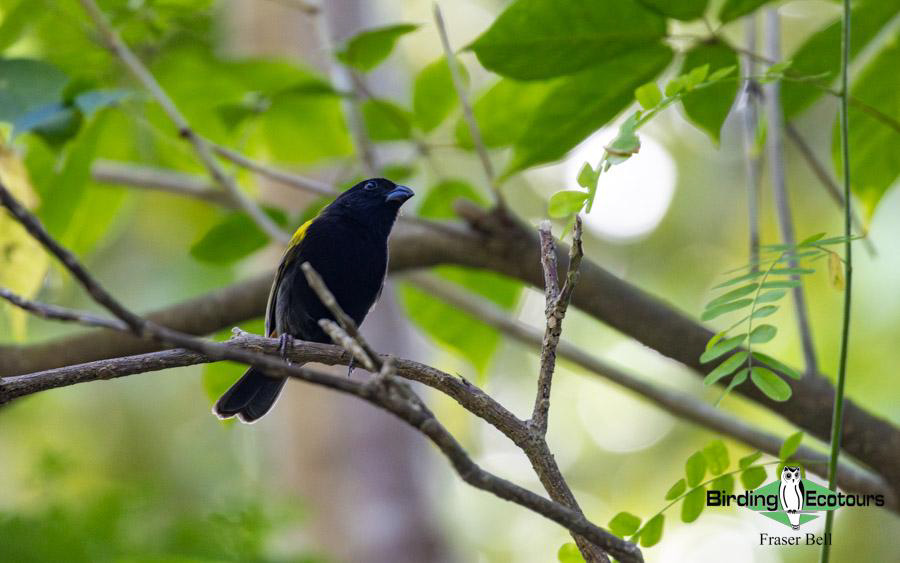
We connected with Yellow-shouldered Grassquit most days during the tour.
Bird List – Following IOC (Version 14.2/August 2024)
All species were seen, aside from the birds marked with (H) after the common name, which were ‘heard only’.
The following notation after species names is used to show conservation status following BirdLife International: EN = Endangered, VU = Vulnerable. (Endemic) = Jamaican endemic birds.
| Common Name | Scientific Name |
| Ducks, Geese, and Waterfowl (Anatidae) | |
| Blue-winged Teal | Spatula discors |
| Pigeons and Doves (Columbidae) | |
| Rock Dove | Columba livia |
| White-crowned Pigeon | Patagioenas leucocephala |
| Ring-tailed Pigeon (Endemic) – VU | Patagioenas caribaea |
| Eurasian Collared Dove | Streptopelia decaocto |
| Common Ground Dove | Columbina passerina |
| Crested Quail-Dove (Endemic) | Geotrygon versicolor |
| Ruddy Quail-Dove | Geotrygon montana |
| Caribbean Dove | Leptotila jamaicensis |
| White-winged Dove | Zenaida asiatica |
| Zenaida Dove | Zenaida aurita |
| Mourning Dove | Zenaida macroura |
| Cuckoos (Cuculidae) | |
| Smooth-billed Ani | Crotophaga ani |
| Mangrove Cuckoo | Coccyzus minor |
| Chestnut-bellied Cuckoo (Endemic) | Coccyzus pluvialis |
| Jamaican Lizard Cuckoo (Endemic) | Coccyzus vetula |
| Potoos (Nyctibiidae) | |
| Northern Potoo | Nyctibius jamaicensis |
| Swifts (Apodidae) | |
| White-collared Swift | Streptoprocne zonaris |
| Antillean Palm Swift | Tachornis phoenicobia |
| Hummingbirds (Trochilidae) | |
| Jamaican Mango (Endemic) | Anthracothorax mango |
| Vervain Hummingbird | Mellisuga minima |
| Red-billed Streamertail (Endemic) | Trochilus polytmus |
| Black-billed Streamertail (Endemic) | Trochilus scitulus |
| Rails, Gallinules, and Coots (Rallidae) | |
| American Coot | Fulica americana |
| Purple Gallinule | Porphyrio martinica |
| Stilts and Avocets (Recurvirostridae) | |
| Black-necked Stilt | Himantopus mexicanus |
| Plovers and Lapwings (Charadriidae) | |
| Grey Plover – VU | Pluvialis squatarola |
| American Golden Plover | Pluvialis dominica |
| Killdeer | Charadrius vociferus |
| Semipalmated Plover | Charadrius semipalmatus |
| Wilson’s Plover | Anarhynchus wilsonia |
| Jacanas (Jacanidae) | |
| Northern Jacana | Jacana spinosa |
| Sandpipers and Allies (Scolopacidae) | |
| Spotted Sandpiper | Actitis macularius |
| Lesser Yellowlegs – VU | Tringa flavipes |
| Ruddy Turnstone | Arenaria interpres |
| Sanderling | Calidris alba |
| Least Sandpiper | Calidris minutilla |
| Gulls, Terns, and Skimmers (Laridae) | |
| Laughing Gull | Leucophaeus atricilla |
| Ring-billed Gull | Larus delawarensis |
| Cabot’s Tern | Thalasseus acuflavidus |
| Royal Tern | Thalasseus maximus |
| Grebes (Podicipedidae) | |
| Least Grebe | Tachybaptus dominicus |
| Pied-billed Grebe | Podilymbus podiceps |
| Tropicbirds (Phaethontidae) | |
| White-tailed Tropicbird | Phaethon lepturus |
| Frigatebirds (Fregatidae) | |
| Magnificent Frigatebird | Fregata magnificens |
| Ibises and Spoonbills (Threskiornithidae) | |
| American White Ibis | Eudocimus albus |
| Glossy Ibis | Plegadis falcinellus |
| Herons, Egrets, and Bitterns (Ardeidae) | |
| Least Bittern | Botaurus exilis |
| Yellow-crowned Night Heron | Nyctanassa violacea |
| Black-crowned Night Heron | Nycticorax nycticorax |
| Little Blue Heron | Egretta caerulea |
| Tricoloured Heron | Egretta tricolor |
| Reddish Egret | Egretta rufescens |
| Snowy Egret | Egretta thula |
| Green Heron | Butorides virescens |
| Western Cattle Egret | Ardea ibis |
| Great Egret | Ardea alba |
| Great Blue Heron | Ardea herodias |
| Pelicans (Pelecanidae) | |
| Brown Pelican | Pelecanus occidentalis |
| New World Vultures (Cathartidae) | |
| Turkey Vulture | Cathartes aura |
| Osprey (Pandionidae) | |
| Osprey | Pandion haliaetus |
| Hawks, Eagles, and Kites (Accipitridae) | |
| Red-tailed Hawk | Buteo jamaicensis |
| Owls (Strigidae) | |
| Jamaican Owl (Endemic) | Asio grammicus |
| Todies (Todidae) | |
| Jamaican Tody (Endemic) | Todus todus |
| Kingfishers (Alcedinidae) | |
| Belted Kingfisher | Megaceryle alcyon |
| Woodpeckers (Picidae) | |
| Jamaican Woodpecker (Endemic) | Melanerpes radiolatus |
| Falcons and Caracaras (Falconidae) | |
| American Kestrel | Falco sparverius |
| New World and African Parrots (Psittacidae) | |
| Black-billed Amazon (Endemic) – EN | Amazona agilis |
| Yellow-billed Amazon (Endemic) – VU | Amazona collaria |
| Rose-ringed Parakeet | Psittacula krameri |
| Green-rumped Parrotlet | Forpus passerinus |
| Olive-throated Parakeet | Eupsittula nana |
| Tityras and Allies (Tityridae) | |
| Jamaican Becard (Endemic) | Pachyramphus niger |
| Tyrant Flycatchers (Tyrannidae) | |
| Jamaican Elaenia (Endemic) | Myiopagis cotta |
| Greater Antillean Elaenia | Elaenia fallax |
| Jamaican Pewee (Endemic) | Contopus pallidus |
| Sad Flycatcher (Endemic) | Myiarchus barbirostris |
| Rufous-tailed Flycatcher (Endemic) | Myiarchus validus |
| Stolid Flycatcher | Myiarchus stolidus |
| Grey Kingbird | Tyrannus dominicensis |
| Loggerhead Kingbird | Tyrannus caudifasciatus |
| Vireos, Shrike-Babblers, and Erpornis (Vireonidae) | |
| Blue Mountain Vireo (Endemic) | Vireo osburni |
| Jamaican Vireo (Endemic) | Vireo modestus |
| Black-whiskered Vireo | Vireo altiloquus |
| Crows, Jays, and Magpies (Corvidae) | |
| Jamaican Crow (Endemic) | Corvus jamaicensis |
| Swallows (Hirundinidae) | |
| Barn Swallow | Hirundo rustica |
| Cave Swallow | Petrochelidon fulva |
| Mockingbirds and Thrashers (Mimidae) | |
| Bahama Mockingbird | Mimus gundlachii |
| Northern Mockingbird | Mimus polyglottos |
| Thrushes and Allies (Turdidae) | |
| Rufous-throated Solitaire | Myadestes genibarbis |
| White-chinned Thrush (Endemic) | Turdus aurantius |
| White-eyed Thrush (Endemic) | Turdus jamaicensis |
| Weavers and Allies (Ploceidae) | |
| Yellow-crowned Bishop | Euplectes afer |
| Waxbills and Allies (Estrildidae) | |
| Scaly-breasted Munia | Lonchura punctulata |
| Chestnut Munia | Lonchura atricapilla |
| Old World Sparrows (Passeridae) | |
| House Sparrow | Passer domesticus |
| Finches, Euphonias, and Allies (Fringillidae) | |
| Jamaican Euphonia (Endemic) | Euphonia jamaica |
| Spindalises (Spindalidae) | |
| Jamaican Spindalis (Endemic) | Spindalis nigricephala |
| Troupials and Allies (Icteridae) | |
| Jamaican Oriole | Icterus leucopteryx |
| Jamaican Blackbird (Endemic) – EN | Nesopsar nigerrimus |
| Shiny Cowbird | Molothrus bonariensis |
| Great-tailed Grackle | Quiscalus mexicanus |
| Greater Antillean Grackle | Quiscalus niger |
| New World Warblers (Parulidae) | |
| Ovenbird | Seiurus aurocapilla |
| Worm-eating Warbler | Helmitheros vermivorum |
| Northern Waterthrush | Parkesia noveboracensis |
| Black-and-white Warbler | Mniotilta varia |
| Prothonotary Warbler | Protonotaria citrea |
| Common Yellowthroat | Geothlypis trichas |
| Arrowhead Warbler (Endemic) | Setophaga pharetra |
| American Redstart | Setophaga ruticilla |
| Cape May Warbler | Setophaga tigrina |
| Northern Parula | Setophaga americana |
| Magnolia Warbler | Setophaga magnolia |
| Mangrove Warbler | Setophaga petechia |
| Black-throated Blue Warbler | Setophaga caerulescens |
| Palm Warbler | Setophaga palmarum |
| Prairie Warbler | Setophaga discolor |
| Tanagers and Allies (Thraupidae) | |
| Saffron Finch | Sicalis flaveola |
| Bananaquit | Coereba flaveola |
| Yellow-faced Grassquit | Tiaris olivaceus |
| Orangequit (Endemic) | Euneornis campestris |
| Greater Antillean Bullfinch | Melopyrrha violacea |
| Yellow-shouldered Grassquit (Endemic) | Loxipasser anoxanthus |
| Black-faced Grassquit | Melanospiza bicolor |
| Total seen | 125 |
Other Wildlife – Following the IUCN Red List
| Common Name | Scientific Name |
| Mongooses (Herpestidae) | |
| Indian Brown Mongoose | Urva auropunctata |
| Crocodiles (Crocodylidae) | |
| American Crocodile | Crocodylus acutus |
| Anoles (Anolidae) | |
| Stripefoot Anole (Endemic) | Anolis lineatopus |
| Jamaican Giant Anole (Endemic) | Anolis garmani |
| Graham’s Anole (Endemic) | Anolis grahami |
| Jamaican Twig Anole (Endemic) | Anolis valencienni |
| Dwarf Geckos (Sphaerodactylidae) | |
| Croaking Lizard | Aristelliger praesignis |
| True Toads (Bufonidae) | |
| South American Cane Toad | Rhinella marina |
| Total | 8 |
DOWNLOAD TRIP REPORT
This is a sample trip report. Please email us ([email protected]) for more trip reports from this destination.
JAMAICA BIRDING TOUR: ISLAND ENDEMICS IN THE HEART OF THE CARIBBEAN
TOUR-SPECIFIC INFORMATION
TOUR OUTLINE
On this birding adventure we explore the beautiful island nation of Jamaica. This tour begins with birding around the bustling capital, Kingston, where we will visit wetlands and dry-forest to target, amongst others, Stolid Flycatcher and Bahama Mockingbird, both species with restricted global ranges. Next, we ascend into the breathtaking Blue Mountains National Park, home to some of Jamaica’s rarest birds, including Crested Quail-Dove, Rufous-throated Solitaire, and Greater Antillean Elaenia. We stay at the charming Starlight Chalet, an eco-lodge that serves as the perfect base for exploring the Blue Mountains, offering great sightings of many of Jamaica’s endemic species right from its grounds. Midway through the tour, we head to the northeast, into Portland Parish, where we check into a peaceful group of villas overlooking the Caribbean Sea. With two full days of birding in this remote area, we will explore the famous Ecclesdown Road, searching for any remaining Jamaican endemics we have yet to see, which might include Jamaican Owl, Black-billed Amazon, and Black-billed Streamertail – one of the best hummingbirds in the world. We will also make a special effort to look for wintering migrants and the stunning White-tailed Tropicbird. This tour is perfect for a great week of birding in a true tropical paradise.
PASSPORT, VISA, AND ENTRY FORM
Most visitors do not require a visa to visit Jamaica if staying for fewer than 90 days, however, you will need proof of your intended departure date and a return ticket to another country. Please make sure that you bring a photocopy of your passport with you on the tour, to be kept in a different location to your original passport, in case of loss/damage. This can be kept with other important documents such as vaccine certificate, emergency contact details, and insurance documents.
Australian, and United States (US) citizens need to have at least six months’ validity remaining in their passports, and at least one blank page for entry and exit stamps. British/United Kingdom (UK) citizens and Canadian citizens only need their passports to be valid for the expected duration of the stay within Jamaica, but UK citizens need to have at least two blank pages for entry and exit stamps. Refer to the information here for US citizens, here for UK citizens, here for Canadian citizens, and here for Australian citizens, and please check these websites for any recent changes to ensure you are suitably covered.
Citizens of other countries should check their own governments’ advice and contact their nearest embassies/consulates for up-to-date regulations and requirements.
Jamaica requires an entry form (C5 form) to be completed before arrival into the country, which can be completed online by following this link. This can be completed up to thirty days prior to arrival but must be completed at least the day before arrival.
TRAVEL INSURANCE
As per our standard Terms and Conditions, we strongly recommend that you buy trip cancellation insurance to protect yourself against medical issues, accidents, illness, repatriation, loss of valuables or luggage, and travel interruptions or delays of all kinds.
CRIME
Since the early 2000s Jamaica has unfortunately reported high levels of gang-related crime. While the people are friendly and welcoming, travelers can be targeted in certain areas. Incidents involving international visitors are primarily concentrated in specific parts of Kingston, Montego Bay, and Spanish Town, especially in the evening or at night. However, we have carefully designed this itinerary to avoid high-crime areas, staying primarily on private land or in remote locations far from where crime is reported. Throughout the tour, we will always be accompanied by a local guide or a trusted transfer service when outside accommodation grounds. While there are very few nocturnal activities planned during the tour, any night outings will take place in the remote northeast, well away from areas of concern. We also maintain constant communication with local guides and accommodation providers, who have reported no issues at the sites we visit.
In response to safety concerns, we have adjusted the itinerary to avoid high-crime areas in Kingston. For the first night of the tour, we stay in a hotel with 24-hour security, located in a safe part of the city. On our first morning, we hope to visit wetlands northwest of Kingston and the arid Hellshire Hills to the southwest—both of which are outside of high-risk areas and can be accessed safely. We will be accompanied by a local guide who regularly leads tours to these sites. If conditions change, we will not visit these sites, and instead we will depart earlier for the Blue Mountains where we will be in the remote highlands away from Kingston.
While the overall risk remains low, we encourage all participants to remain mindful that crime is a possibility throughout the trip. Please take extra care of personal belongings and ensure that no valuables are left visible in unattended vehicles.
Additionally, we advise you:
- Do not independently explore Kingston before or after the tour. If you are interested in doing so, book private transfers and use known tour operators.
- Be increasingly cautious whilst traveling after dark.
- Be mindful of optics and mobile phones when we are birding outside of the hotel grounds.
- Avoid solo traveling.
- Do not use public transport, book private transfers in advance and do not use local unmarked cars as a taxi.
- Be extra vigilant when visiting ATMs, and don’t carry large amounts of cash.
- Use the hotel safe to secure your valuables.
- Leave valuable jewelry at home.
This is general advice, for more information please visit your respective government advisory. Refer here for US citizens, here for UK citizens, here for Canadian citizens, and here for Australian citizens, and please check these websites for any recent changes to ensure you are suitably covered.
HEALTH, VACCINATIONS, AND MEDICAL CONDITIONS
Malaria is not present in Jamaica, however, Dengue fever and other insect-borne diseases, although uncommon, are present and so we recommend taking personal protective measures. These include using mosquito repellent, wearing long pants, and long-sleeved shirts, particularly at night when mosquitos and other biting insects are active. Please carefully read the CDC traveler advice here which contains information on required vaccinations to enter Jamaica. Please note, Jamaica requires a valid Yellow Fever Certificate if you are traveling from a region where yellow fever is present.
Please make sure that you are covered with suitable medical insurance in case of an emergency while on the tour, because without insurance the cost for medical care is likely to be extremely high. The US travel advice currently suggests obtaining medical evacuation insurance before traveling to Jamaica.
As per our general Terms and Conditions, we require you to notify us at the time of registering for this tour of any medical conditions that we should know about (these should include, but not be limited to, walking/mobility issues, allergies, heart conditions, diabetes, epilepsy, long-term illnesses etc.). While Jamaica is a relatively small island, at times on this tour we are in remote areas away from hospitals and medical facilities.
DANGEROUS ANIMALS
While Jamaica has very few venomous snakes, we will be visiting areas inhabited by these snakes, and as usual, we will be very lucky to see any. We recommend hiking boots, jeans/long trousers, and a good dose of care to minimize the danger of snakebites. We do not take anti-venom on our tours but will try and rush you to a private hospital if you do get bitten (although we will often be in remote places); your own travel insurance (especially medical insurance) is crucial. Scorpions and spiders can cause problems (check your shoes/boots before putting them on), but there are no large terrestrial mammals on Jamaica to worry about. Continual care about placing hands and feet will reduce the chance of an unexpected encounter with something like a snake, spider, or scorpion.
FOOD AND WATER
Water is generally potable in towns and cities, and at our accommodations, but it is best to drink bottled water while we are birding, as we will be visiting rural areas. An ample supply of drinking water is available throughout the tour in our vehicle, so please bring a refillable water bottle to try and reduce the amount of plastic waste. Ice is considered safe in high-standard restaurants and hotels but should probably be avoided in rural areas or on street stalls.
Mealtimes are likely to be within normal eating hours, but these will be somewhat flexible depending on our birding/travel plans and so if you need to eat food at a specific time of day (e.g. to agree with medication you are on) you may need to bring snacks to supplement the above, such as cereal bars/protein bars, dried fruit etc. There are limited opportunities to purchase snacks from convenience stores on this trip, so if you want items that are familiar, it is probably best to bring these from home. Different dietary preferences are well catered for in Jamaica, and both local and westernised food is readily available across the country.
CURRENCY
The official currency of Jamaica is the Jamaican dollar (JMD/J$), with banknotes available in denominations of 50, 100, 500, 1,000, 2,000, and 5,000 JMD. While the United States dollar (USD) is widely accepted, especially in tourist areas, paying in Jamaican dollars often provides better value. It’s advisable to carry some local currency for smaller purchases and to avoid unfavorable exchange rates.
Visa and Mastercard are widely accepted at restaurants, shops, and hotels in major towns and cities and can be used for drawing cash from ATMs (bank charges may apply). Check with your card supplier whether you need to notify them of your trip to Jamaica, so you don’t find your card disabled on your arrival in the country.
It will be possible to exchange or draw money at the airport, and during our time in Kingston, but it will be easier all round to either bring cash with you from home or sort it out at the airport. A small amount of local cash will be useful for personal purchases for items not included in the tour costs and for any gratuities. See the full list of what is/isn’t included in the tour cost in the itinerary document here. Remember to remain vigilant when using ATMs for your safety and security.
ELECTRICITY AND COMMUNICATION
Electricity is 110 V with the standard type A and type B electrical sockets (both have two flat parallel pins; type B has a grounding pin, see here for pictures). Although the electrical sockets are the same as in North America, not all sockets in Jamaica will be polarized (i.e. they are commonly type A) so you may still need an international adapter to use your plug, if you intend to recharge electrical devices, video batteries etc. in your room. All hotels and lodges we use have Wi-Fi, though it is only available in the public areas of the lodge in the Blue Mountains. Phone coverage is typically good throughout Jamaica, but it can be patchy when we are in the Blue Mountains, or when out birding in more remote areas such as Ecclesdown Road.
ACCOMMODATION
We stay in a range of accommodation on the tour. Most of the accommodation is of a good standard, however the lodge in the Blue Mountains is more basic. The more basic accommodation is the only option for when birding in this remote area and gives us access to great birding right outside our rooms. All rooms (everywhere we stay) have air conditioning and/or a fan (air conditioning is not really considered necessary while staying in the mountains, where it is cooler). All rooms have private bathrooms with hot water, 24-hour electricity, and all have Wi-Fi connections. Laundry services are available throughout the tour. We use “standard” rooms on this tour, as is typical of most group birding tours around the world, and these are deemed by us to be sufficient for most people. If you would like to upgrade to a higher standard of room, such as a “luxury” room, this might be possible, depending on availability in some, but not all locations. Please note that there would be an extra charge for upgrading your room, please contact us to discuss options as far ahead of the tour commencement date as possible.
WEATHER
Jamaica, located in the Caribbean just south of the Tropic of Cancer, enjoys a warm tropical climate year-round, with temperatures moderated by the Northeast Trade Winds. The island experiences two main seasons. The dry season, from December to April, brings warm but comfortable weather, with January and February the coolest months. Rainfall is at its lowest between January and March. The wet season, from May to November, is hotter and more humid. July and August are the hottest months, with temperatures reaching up to 90°F (32°C) and rarely falling below 77°F (25°C) at night. Rainfall is highest in May, June, October, and November. While hurricanes are possible between June and November, Jamaica is less frequently impacted than neighboring islands.
On this tour, we visit Jamaica at the end of March, during the dry season when daytime temperatures average around 79°F (26°C), cooling at night to around 72°F (22°C). We spend two full days in the Blue Mountains at an altitude of approximately 4,260 feet (1,300 meters) above sea level, where temperatures will be noticeably cooler than the lowlands. Short showers are possible during our tour, but prolonged rainfall is unlikely. Given its tropical climate, humidity in Jamaica is high, especially in the lowlands. To make the most of the comfortable morning weather, we will start early and adjust the afternoon schedule based on temperature and bird activity.
SOME THINGS WE RECOMMEND YOU BRING ON THIS JAMAICAN BIRDING TOUR
Clothing
In Jamaica, we expect the weather to be warm to hot during the day, so hot weather clothes are recommended as are a hat, sunglasses, and sunscreen. The weather is often mild at night, and for our two-night stay in the Blue Mountains temperatures may drop, so we recommend bringing long pants and sweaters. We will be birding through lowland and coastal rainforest which often have biting insects, particularly in the last two full tour days, so mosquito repellent, and long sleeves and long pants are advised. This tour is run in the dry season, which is great for birding (when Jamaica hosts many migratory species from North America), and means we shouldn’t have much rain throughout the tour. That said, waterproofs are advised as we may encounter some light showers during the tour. There will be opportunity to swim during the tour. Camouflage clothing is strictly prohibited in Jamaica.
Equipment
Don’t forget your binoculars and camera! If you’re unsteady on your feet, a hiking pole or walking stick is mandatory, especially while we are birding forest trails in the Blue Mountains National Park. Lightweight hiking boots are the best footwear for this tour with much of the birding along roads rather than long hikes through the forest. Sandals (flip-flops) or trainers are useful for walking around some of the accommodations but are not suitable for birding time (consider snake bites, mud, slips, and falls). We will be night birding on at least one night, and a flashlight or headlamp will be useful for this and are always useful in case of an unexpected power cut.
BIRDING ECOTOURS EMERGENCY CONTACT DETAILS
Office: Cane +27-72-211-9863, Chris +44-7808-571-444
E-mail: [email protected] (which is checked almost daily)
FIELD GUIDES
Birds of the West Indies (Kirwan, Levesque, Oberle, and Sharpe, 2019) – The best available bird guide for Jamaica and for the whole Caribbean. The illustrations are excellent and fit together seamlessly. Unusually the range maps are included on the plates, but this works well. There is a QR code for each species that links to the Internet Bird Collection database, allowing you to access a greater array of photographs, videos, and sounds.
Birds of the West Indies (Garrido, Keith, and Raffaele, 2020) – This guide is lighter and slimmer than the aforementioned field guide, but the illustrations, text and range maps are not as good, which makes this guide harder to use.
A Photographic Guide to the Birds of Jamaica (Haynes-Sutton, Downer, and Sutton, 2009) – A great guide and some may prefer this to the Birds of the West Indies as it only includes Jamaican species, but it is outdated and less useful in the field.
USEFUL APPS AND WEBSITE RESOURCES
Aves Vox – a good app that enables the downloading of bird songs and calls from the xeno-canto website onto your cell phone.
eBird – there is a wealth of information contained on this website and the mobile app is now excellent and useful too. Photo, video, and sound galleries are available for practically every species in the world through The Cornell Lab of Ornithology’s Macaulay Library.
Merlin – an app that can help you identify birds by sight (from photos) and sound (from recordings) and is a useful tool to aid bird identification. The app is getting expanded all the time with new data and regional information so is worth keeping an eye on. We recommend downloading the West Indies pack for this tour.
IOC World Bird List – this website contains all the latest details on the world of global bird taxonomy. You can read about newly described species, splits (creation of a new species) and lumps (deletion of a species) of existing species, and plenty of other important information.
Our guide, Fraser, was so knowledgeable and personable on our Jamaica tour; we’d like to go with him again. He gave recommendations to help chose the best guidebook for me. He made sure to get everyone on each bird, using the laser pointer when needed. We got every island endemic! In addition to the endemics, I added many more birds to my Life List. We celebrated when I reached 1,000 birds! Fraser also spotted two rarities that were not target birds, but he knew they were rarely found on Jamaica – further demonstrating his expertise. Furthermore, Fraser shared daily eBird lists with me, which was very helpful. He said that’s the standard for Birding Ecotours.
We also liked our local driver. He was a very careful driver is also the 2nd top eBirder in Jamaica. He knew the bird calls and often located the target birds for us.
The trip was very well organized, and the accommodations were just what we needed. The food was top quality, and when Fraser and Lyndon found out we enjoyed Jamaican cuisine, they went out of their way to let us try local specialties. We wouldn’t hesitate to go with Birding Ecotours again.
